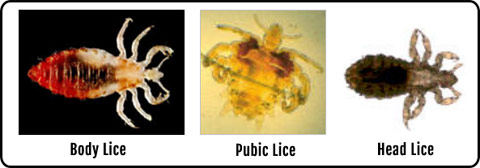Body Lice
Report a Case
Disease Reporting Line:
(808) 586-4586
About This Disease
Body lice are small, usually pale- to grey-colored insects that live and reproduce in clothing worn by humans. Body lice feed on human blood and can survive only on people. The oblong eggs (called “nits”) are usually tan- or brown-colored but can appear whitish under bright lights. They are about 1 to 2 mm long. The nits hatch after about 1 week then pass through 3 stages (over 1 to 2 weeks) before becoming full-sized adults that are about 2 to 3 mm long.
Signs and Symptoms
The reactions to or results of louse feedings may be the first symptoms noted. Bites can cause itching at the feeding sites. Scratching may break the skin and lead to skin infections. Feeding sites may look like small, red dots on the skin. Body lice are known to transmit bacterial infections that cause three human diseases: louse-borne typhus (Rickettsia prowazeki), trench fever (Rochalimaea quintana), and louse-borne relapsing fever (Borrelia recurrentis).
Transmission
Body lice are spread through direct person-to-person contact with someone who has body lice. It can also be spread through contact of clothing, beds, bed linens, or towels that have been in contact with someone who has body lice.
Diagnosis
There is no laboratory test to confirm body lice. Body lice can be diagnosed by finding eggs and crawling lice in the seams of clothes. Sometimes a body louse can be seen crawling on skin during feeding.
Treatment
Wash clothing, bedding, and towels using hot water and dry with high heat. Improve personal hygiene for the infested person. Medicated lotions can be used on the body as well.
Risk in Hawaii
There are no statistics on how many people have been infected with body lice in Hawaii. In the United States, body lice infestations are only found in homeless or transient populations who do not have access to regular bathing or clean clothes. Infestation is unlikely to persist on anyone who bathes regularly and who has at least weekly access to freshly laundered clothing and bedding.
Prevention
Reduce the risk of catching body lice by bathing regularly, changing and washing clothes, and avoiding potentially infested bedding.




